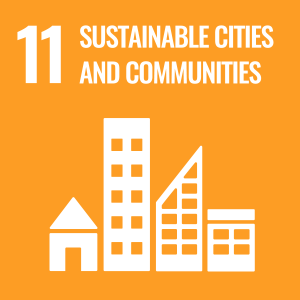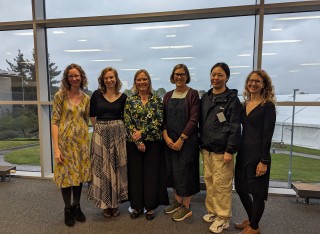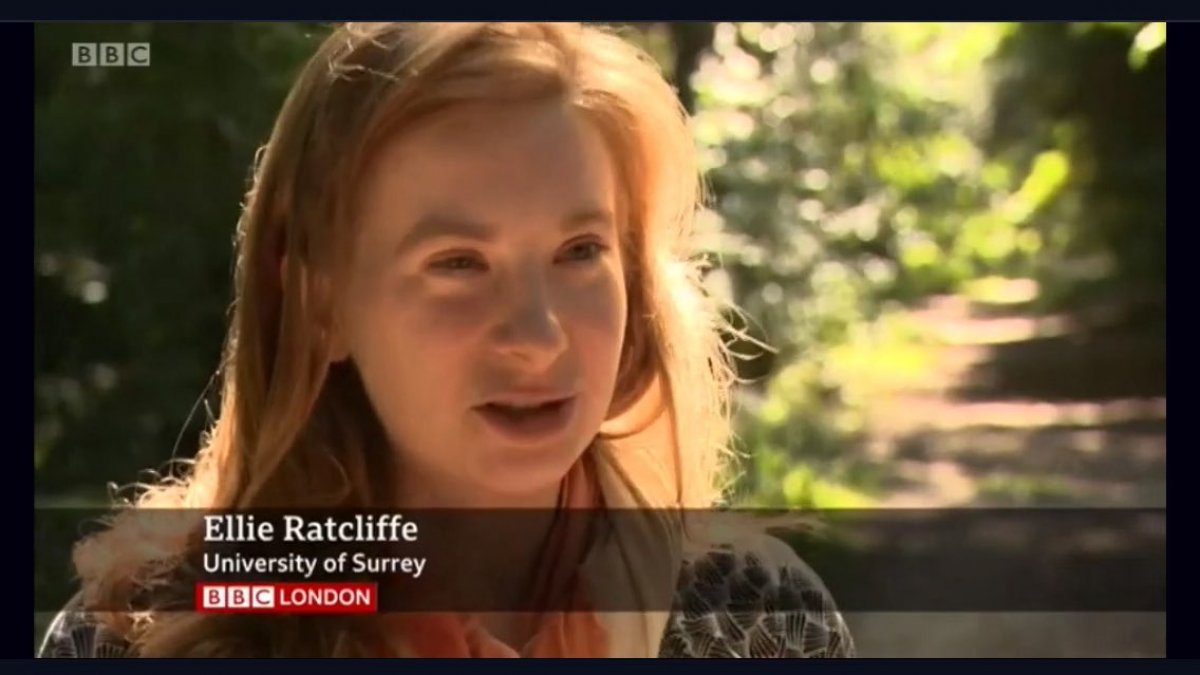
Dr Eleanor Ratcliffe
Pronouns: she/her
Academic and research departments
Environmental Psychology Research Group (EPRG), School of Psychology, Faculty of Health and Medical Sciences, Institute for Sustainability.About
Biography
My research mainly concerns restorative environments, or places which help people to recover psychologically from stress and/or cognitive fatigue. I focus particularly on sensory aspects of these environments (e.g., sounds and soundscapes) and on how bonds between people and place can enhance links between environment and wellbeing. I completed my PhD at Surrey in 2015, followed by two periods of postdoctoral research (2015-2017 at Tampere University, Finland, and 2017-2018 at Imperial College London), before returning to Surrey in January 2019.
Areas of specialism
University roles and responsibilities
- Programme lead, MSc Environmental Psychology
- Fellow, Institute for Sustainability
- 2022-2024: Academic Integrity Officer, FHMS
- 2019-2022: Senior Professional Training Year (PTY) Tutor
Affiliations and memberships
Business, industry and community links
News
In the media
ResearchResearch interests
Restorative environments:
- Natural sounds and soundscapes
- Virtual reality experiences of nature
- Nature and creativity
- Restoration in urban and indoor settings
Person-place bonds:
- Favourite places and self-regulation
- Place attachment and identity
- Place memory
Consumer perceptions and behaviour:
- Consumer rituals, especially relating to food and drink
- Experiences of retail spaces
- Servicescapes and 'third places'
I regularly review manuscripts for academic journals such as Journal of Environmental Psychology, Health and Place, Environment & Behavior, Landscape and Urban Planning, and Urban Forestry & Urban Greening. I am an Associate Editor of Frontiers in Psychology (Environmental Psychology subsection).
Research projects
2026-2028: Inclusive Mobility Interventions for Young Adolescents and Livable Urban Spaces (i-MOBYL) The i-MOBYL project will identify, co-create, and implement inclusive, evidence-based design and policy interventions that empower young adolescents across diverse European contexts to engage in out-of-home activities using active and multimodal travel. It employs a mixed-methods, interdisciplinary, and participatory approach, integrating transport studies, urban planning and design, behavioural science, co-design and public health. This is a European consortium project led by Eindhoven University of Technology and funded by the Driving Urban Transitions Partnership. University of Surrey leads the Evaluation Work Package. All outputs are developed with active involvement from young adolescents of diverse backgrounds in five partner locations, including Basel (CH), Eindhoven (NL), Guildford (UK), Paris (FR) and Salzburg (AT).
2024-2025: Measuring the Tranquil City - Co-design and development of an Impact Assessment Toolkit for equitable urban wellbeingThis project was funded via a British Academy Innovation Fellowship. I worked with Tranquil City, an SME dedicated to urban wellbeing, to develop an Impact Assessment Toolkit that can: 1) demonstrate the benefits of active travel and green space interventions for wellbeing and sustainable behaviour, especially for communities at risk of health inequalities; and 2) communicate those benefits to public, private, and third sector stakeholders, to drive adoption of sustainable development and lifestyle practices at city levels. This was achieved through co-design with stakeholders; testing and validating the toolkit in wider communities; and integration of the toolkit into Tranquil City’s Make My City Thrive service.
Engagement with nature supports health and wellbeing, but Lesbian, Gay, Bisexual, Trans and Queer (LGBTQ+) people experience inequalities in access to and safe enjoyment of natural spaces. By facilitating knowledge exchange between the LGBTQ+ community and land managers, Co-Producing Pride in Nature (Nov 2024 – July 2025) aimed to support inclusive nature engagement, enable development of an interdisciplinary research agenda relevant to non-academic priorities, and facilitate professional development of students and non-academic practitioners. Outputs from this project include an inclusivity action plan for land stewards and artworks created by LGBTQ+ community members. You can find these at our project website: https://prideinnature.wordpress.com
Partners: Blossom LGBT CIC and Surrey Wildlife Trust. Funded by the Higher Education Innovation Fund (HEIF).
This project deepens understanding regarding the development of and relationship between coping with environment-related emotions, nature connectedness and pro-environmental behaviour. Based on this, we aim to develop - in collaboration with multidisciplinary scientists - and test a nature-based group intervention programme (Act with Nature; AWN) to support behavior change. We compare findings between Finland and the United Kingdom. Our framework builds on a novel, nature-based approach and we aim to create long-term impacts on well-being of human and non-human nature.
Partners: Tampere University, Jyväskylä University of Applied Sciences, University of Surrey. Funded by Academy of Finland.
This interdisciplinary project involved collaboration between ecologists, psychologists and economists. We developed the mechanistic understanding of the pathways linking landscape structure, soundscape complexity, perceptions of soundscape quality, derived mental health and well-being benefits, and economic values required to achieve this. We used a novel approach that combines bird monitoring data with existing recordings of individual species to construct simulated natural soundscapes across the UK and relate their acoustic properties to local habitat and landscape characteristics. Using both laboratory and online experiments, we explored short-term responses to and long-term implications of exposure to soundscapes with varying acoustic characteristics, examining the contextual and individual factors which drive variation in the strengths of these relationships. We also examined the psychological mechanisms that underpin these relationships and investigate whether human noise reduces the benefits of natural soundscapes.
Partners: University of East Anglia, University of Surrey, University of Glasgow. Funded by NERC
Caring—with Cities aimed to understand how care is embedded into community-led and policy-led urban development, the interface between the two, and how it can be designed into future urban policy at a systemic level. In dialogue with 3-5 UK case studies of care-full community-led development, the project drew upon organisational and community archival research; in-depth interviews and facilitated group conversations. A preliminary system mapping of case studies explored the interface with policy to identify soft infrastructures of care. More detailed mapping, revealing where these dynamics are already present, also provided provide insights into opportunities for caring—with, suggesting directions for policy design with links to national and international urban policies.
Partners: Northumbria University, UCL, Sheffield Hallam University, University of Surrey, University of Lancaster. Funder: British Academy.
The University of Surrey worked in partnership with MyGlobalHome to trial and demonstrate a state-of-the-art modular, smart home concept on the University campus. In addition to providing accommodation for our staff and students, the MyGlobalHome development provided the University with a set of physical ‘Living Labs’, where we can work collaboratively to better understand and shape the future of Urban Living.
This work began as a seed-funded project (2020/21) exploring environmental concerns among residents of Southway in North West Guildford. As we progressed we discovered a need for more engaged work with residents to understand wider social and community-based priorities. This has been the focus of our work in 2021/22, which involves mapping of existing community groups and initiatives, identification of key community priorities beyond the physical environment, and developing an action plan with the community to design and source funding for an appropriate local solution or resource.
Partners: Guildford Borough Council, local residents, and staff across the University. Funded by ESRC Impact Acceleration Account and the Higher Education Innovation Fund (HEIF).
Research interests
Restorative environments:
- Natural sounds and soundscapes
- Virtual reality experiences of nature
- Nature and creativity
- Restoration in urban and indoor settings
Person-place bonds:
- Favourite places and self-regulation
- Place attachment and identity
- Place memory
Consumer perceptions and behaviour:
- Consumer rituals, especially relating to food and drink
- Experiences of retail spaces
- Servicescapes and 'third places'
I regularly review manuscripts for academic journals such as Journal of Environmental Psychology, Health and Place, Environment & Behavior, Landscape and Urban Planning, and Urban Forestry & Urban Greening. I am an Associate Editor of Frontiers in Psychology (Environmental Psychology subsection).
Research projects
The i-MOBYL project will identify, co-create, and implement inclusive, evidence-based design and policy interventions that empower young adolescents across diverse European contexts to engage in out-of-home activities using active and multimodal travel. It employs a mixed-methods, interdisciplinary, and participatory approach, integrating transport studies, urban planning and design, behavioural science, co-design and public health. This is a European consortium project led by Eindhoven University of Technology and funded by the Driving Urban Transitions Partnership. University of Surrey leads the Evaluation Work Package. All outputs are developed with active involvement from young adolescents of diverse backgrounds in five partner locations, including Basel (CH), Eindhoven (NL), Guildford (UK), Paris (FR) and Salzburg (AT).
This project was funded via a British Academy Innovation Fellowship. I worked with Tranquil City, an SME dedicated to urban wellbeing, to develop an Impact Assessment Toolkit that can: 1) demonstrate the benefits of active travel and green space interventions for wellbeing and sustainable behaviour, especially for communities at risk of health inequalities; and 2) communicate those benefits to public, private, and third sector stakeholders, to drive adoption of sustainable development and lifestyle practices at city levels. This was achieved through co-design with stakeholders; testing and validating the toolkit in wider communities; and integration of the toolkit into Tranquil City’s Make My City Thrive service.
Engagement with nature supports health and wellbeing, but Lesbian, Gay, Bisexual, Trans and Queer (LGBTQ+) people experience inequalities in access to and safe enjoyment of natural spaces. By facilitating knowledge exchange between the LGBTQ+ community and land managers, Co-Producing Pride in Nature (Nov 2024 – July 2025) aimed to support inclusive nature engagement, enable development of an interdisciplinary research agenda relevant to non-academic priorities, and facilitate professional development of students and non-academic practitioners. Outputs from this project include an inclusivity action plan for land stewards and artworks created by LGBTQ+ community members. You can find these at our project website: https://prideinnature.wordpress.com
Partners: Blossom LGBT CIC and Surrey Wildlife Trust. Funded by the Higher Education Innovation Fund (HEIF).
This project deepens understanding regarding the development of and relationship between coping with environment-related emotions, nature connectedness and pro-environmental behaviour. Based on this, we aim to develop - in collaboration with multidisciplinary scientists - and test a nature-based group intervention programme (Act with Nature; AWN) to support behavior change. We compare findings between Finland and the United Kingdom. Our framework builds on a novel, nature-based approach and we aim to create long-term impacts on well-being of human and non-human nature.
Partners: Tampere University, Jyväskylä University of Applied Sciences, University of Surrey. Funded by Academy of Finland.
This interdisciplinary project involved collaboration between ecologists, psychologists and economists. We developed the mechanistic understanding of the pathways linking landscape structure, soundscape complexity, perceptions of soundscape quality, derived mental health and well-being benefits, and economic values required to achieve this. We used a novel approach that combines bird monitoring data with existing recordings of individual species to construct simulated natural soundscapes across the UK and relate their acoustic properties to local habitat and landscape characteristics. Using both laboratory and online experiments, we explored short-term responses to and long-term implications of exposure to soundscapes with varying acoustic characteristics, examining the contextual and individual factors which drive variation in the strengths of these relationships. We also examined the psychological mechanisms that underpin these relationships and investigate whether human noise reduces the benefits of natural soundscapes.
Partners: University of East Anglia, University of Surrey, University of Glasgow. Funded by NERC
Caring—with Cities aimed to understand how care is embedded into community-led and policy-led urban development, the interface between the two, and how it can be designed into future urban policy at a systemic level. In dialogue with 3-5 UK case studies of care-full community-led development, the project drew upon organisational and community archival research; in-depth interviews and facilitated group conversations. A preliminary system mapping of case studies explored the interface with policy to identify soft infrastructures of care. More detailed mapping, revealing where these dynamics are already present, also provided provide insights into opportunities for caring—with, suggesting directions for policy design with links to national and international urban policies.
Partners: Northumbria University, UCL, Sheffield Hallam University, University of Surrey, University of Lancaster. Funder: British Academy.
The University of Surrey worked in partnership with MyGlobalHome to trial and demonstrate a state-of-the-art modular, smart home concept on the University campus. In addition to providing accommodation for our staff and students, the MyGlobalHome development provided the University with a set of physical ‘Living Labs’, where we can work collaboratively to better understand and shape the future of Urban Living.
This work began as a seed-funded project (2020/21) exploring environmental concerns among residents of Southway in North West Guildford. As we progressed we discovered a need for more engaged work with residents to understand wider social and community-based priorities. This has been the focus of our work in 2021/22, which involves mapping of existing community groups and initiatives, identification of key community priorities beyond the physical environment, and developing an action plan with the community to design and source funding for an appropriate local solution or resource.
Partners: Guildford Borough Council, local residents, and staff across the University. Funded by ESRC Impact Acceleration Account and the Higher Education Innovation Fund (HEIF).
Supervision
Postgraduate research supervision
Current postgraduate research supervision
- Tamala Anderson (primary supervisor): Psychological benefits of place attachment
- Hongyuan Huang (primary supervisory): Blue space and psychological restoration
- George Murrell (primary supervisor): Relationships between loneliness and soundscapes in urban greenspaces
- Bethany Harries (2nd supervisor): The wellbeing garden - examining sensory experiences to inform garden design
- Ruairi Patterson (3rd supervisor): Awe, emotions, and personality
Past supervision
- Sadhana Jagannath (2nd supervisor, PhD completed 2023): Psychological wellbeing in residential environments
- Charlotte Atkin (2nd supervisor, PsychD completed 2023): Nature-based interactions after Acquired Brain Injury
- Chris Wiles (2nd supervisor, PhD completed 2024): Virtual Reality (VR) representations of nature in a psychotherapeutic context
- Mark Newman (2nd supervisor, PhD completed 2025): Using virtual reality to explore how natural environments promote recovery from stress
- Nancy Malamateniou (2nd supervisor. PhD completed 2025): Recovery from work-related stress and rumination
- Elena Somovilla (2nd supervisor, PsychD completed 2025): Climate anxiety and socio-economic status
Undergraduate and MSc supervision
I supervise dissertations on restorative environments, place attachment, sensory experiences of environments, and consumer psychology.
Teaching
I am module convenor for Key Questions in Environmental Psychology (PSY3072/PSYM137) and Academic Research Training (PSYM13), and I teach on Psychology of Architecture and Planning Research (PSYM142).
I give guest lectures on environmental psychology at, for example:
- Center for Urban & Real Estate Management (CUREM), University of Zurich
- Institute of Facility Management (IFM), Zurich University of Applied Sciences
- Real Estate Center, Polytechnic University of Milan
Sustainable development goals
My research interests are related to the following:





Publications
Spending time in natural environments is associated with enhanced well-being, including reduced stress and improved cognitive restoration. This experimental study investigates whether these benefits can be amplified by providing environmental prompts to direct attention towards specific features (natural versus human-made) within the environment.Seventy-nine participants were randomly allocated to one of three conditions: Restorative prompting; Human-made prompting; or control. In the Restorative prompting group, participants were asked to notice natural features within the environment (natural sounds, smells, views, plants and biodiversity). In the human-made prompting group, participants were asked to notice built elements in the environment (buildings, pathways, and human-made sounds). Participants in the control group received no instructions.This study was conducted at Royal Horticultural Society (RHS) Wisley botanical gardens. Measures of state well-being (Short Warwick Edinburgh Mental Wellbeing Scale), positive affect (Discrete Emotions Questionnaire) and perceived restoration (Restoration Outcome Scale) were taken before and after participants spent 20 minutes in the garden completing attentional prompting activities.Participants in the restorative prompting group reported significantly higher state well-being, positive affect and restoration compared to those in the human-made prompting group and the no prompting controls.These findings suggest that the well-being and restorative effects of spending time in natural environments are enhanced when individuals actively attend to nature and emotions. This has significant practical implications for the design and management of natural spaces, both public and private, such as parks and gardens that attract visitors seeking leisure and relaxation. The study provides valuable insights into how people can get the most out of these visits to support and enhance their well-being, highlighting the potential of interventions such as interpretive signage, digital trails or guided experiences to promote more meaningful engagement with nature.
Introduction: Virtual reality (VR) can be extremely useful in simulating nature when physical presence is not possible. Additionally, it allows for environments to be customised (e.g., weather, or topography) and facilitates the design of controlled experimental settings. However, VR can involve the use of expensive equipment and complex software to create highly realistic immersive experiences. But is it necessary for experiences to rival the latest Hollywood blockbuster? This paper explores whether such investment can be valuable in research on nature experiences. Studies: Two studies were conducted to examine how realism of environmental presentations impact affective responses and participant perceptions. Study One (n = 16) explored perceptions of the same lake presented to participants in the real world, in VR and as a video. Study Two (n = 120) compared participant's affective responses to one of four possible virtual environments differing in level of realism (high or low) and type (natural or built). Results: Study One showed that experiences of VR presentations fell between real and video presentations. Study Two found that more realistic VR environments evoked more positive affective and serenity responses, as well as a greater sense of presence. In both studies, participants stressed the importance of naturalistic interaction, sensory immersion, and graphical realism in the experiences, which may help explain these effects. Conclusion: The level of realism that can be attained with VR does impact affective responses and perceptions. Investment in VR for future research can be highly beneficial.
Despite growing interest, public uptake of 'smart home technologies' in the UK remains low. Barriers for accepting and opting to use smart home technologies have been linked to various socio-technical issues, including data governance. Understanding barriers for accepting to use smart home technologies is therefore important for improving their future design. Equally, enabling the public to help shape design features of these technologies from evidence-informed and deliberative approaches is also important. However, this remains an understudied area. This article reports a UK study exploring public opinion towards smart home technologies, using a Citizens' Jury method. Findings indicate that whilst participants identified the benefits of smart home technologies, participants' data sharing intentions and practices are contingent upon the condition of trust in technology developers. Study outcomes could support practitioners and policymakers in making informed, citizen-led decisions about how to adapt existing data governance frameworks pertaining to smart home technologies.
Much research has focused on unwanted sound, or noise, and its links to poor health and wellbeing. In contrast, certain sounds - especially those drawn from nature - are linked to positive outcomes. There is increasing interest in identifying and protecting such sounds within cities to offer opportunities for psychological restoration or recovery. However, explanations of why certain sounds are perceived positively are limited. Theoretical development is needed in order to integrate available evidence into wider work on environment and wellbeing, and this should include attention to perceptual properties of sounds and their interpretations by listeners.
Experience of nature is widely linked to well-being, including psychological restoration. Benefits to creativity have been explored in a limited number of studies which refer to theories of restorative environments as frameworks, but it is unclear which aspects of the environment and person-nature transactions are implicated in these processes. In this study, N = 20 members of the British public were interviewed regarding the relevance of natural environments for their personal and professional creative activities. Thematic analysis of interview transcripts revealed that cognitive, affective, and aesthetic appraisals were reported as directly relevant to creativity in nature, while environmental properties, sensory experiences, and the self were reported as informing these appraisals. Similarities to theories of restorative environments were observed in terms of the relevance of affect, cognition, and aesthetics. However, divergences also occurred, especially with regard to perceptions of arousal as beneficial for creativity, the importance of change in the environment, and the relevance of the self. Studies and theoretical modeling of relationships between nature and creativity should include these concepts, as well as those from theories of restorative environments.
Top–down processing has been highlighted as a potential, but as yet understudied, aspect of restorative environmental experience. In an online study, N = 234 adults resident in Finland rated their favorite Finnish place on measures of perceived restorativeness, perceived restorative outcomes, and place attachment, and provided qualitative descriptions of the place and a positive memory associated with it. Thematic analysis of qualitative data revealed seven themes underpinning place memories: the environment itself, activities within it, cognitive responses, emotional responses, social context, self, and time. Mediated regression analyses showed positive and significant relationships between restorative perceptions and the presence of memories of self and time, as mediated via place attachment (place identity factor). These findings emphasize the contribution of the person to the perception of their restorative experiences in places, particularly in the form of personal memories that can enhance place identity.
Despite sexual wellbeing representing a potential component of the overall wellbeing of individuals, its relationship to indoor soundscape has not been investigated. The aim of this study was to identify acoustic-related variables linked to sexual wellbeing during the COVID-19 lockdown; the mechanisms through which those variables exert an influence; and the components of an ideal indoor soundscape for sexual wellbeing. We did a thematic analysis of answers to an online survey conducted on Jan 18-19, 2021, via the Prolific participant platform. The survey was completed by 464 adult individuals working at home in London during the third national COVID-19 lockdown (Jan 6 to March 8, 2021). This study focused on two optional open-ended questions concerning (1) effects of the acoustic environment on sexual activity and (2) characteristics of an ideal soundscape for best experiencing sexual intercourse. The formation of codes and themes followed a combination of inductive and deductive approaches. 345 responses were collected for question 1 (134 [39%] men, 210 [61%] women, one [
Organisations have implemented intensive home-based teleworking in response to global COVID-19 lockdowns and other pandemic-related restrictions. Financial pressures are driving organisations to continue intensive teleworking after the pandemic. Understanding employees’ teleworking inclinations post COVID-19, and how these inclinations are influenced by different factors, is important to ensure any future, more permanent changes to teleworking policies are sustainable for both employees and organisations. This study, therefore, investigated the relationships between the context of home-based teleworking during the pandemic (pandemic-teleworking conditions), productivity perceptions during home-based teleworking, and employees’ future teleworking inclinations (FTI) beyond the pandemic. Specifically, the study examined whether pandemic-teleworking conditions related to the job, and the physical and social environments at home, influenced employees’ FTI, and if perceptions of improved or reduced productivity mediated these relationships. Data were collected during April and May 2020 with a cross-sectional online survey of teleworkers ( n = 184) in Germany, Switzerland, the United Kingdom, and other countries during the first COVID-19 lockdowns. Reported FTI were mixed. Most participants (61%) reported wanting to telework more post-pandemic compared to before the pandemic; however, 18% wanted to telework less. Hierarchical multiple regression analysis revealed that some teleworking conditions (job demands and work privacy fit) were positively associated with FTI. Other teleworking conditions (specifically, job change, job control, home office adequacy, and childcare) were not associated with FTI. Perceived changes in productivity mediated the relationship between work privacy fit and FTI. Findings highlight the role of work privacy fit and job demands in influencing pandemic productivity perceptions and teleworking inclinations post-pandemic. Results raise questions about the suitability and sustainability of home-based teleworking for all staff. As organisations plan to increase the proportion of teleworking post-pandemic, this study suggests there is a need to support employees who perceived their productivity to be poor while home-working during the pandemic.
Most studies on psychological restoration and favorite places have addressed restoration in green or blue outdoor settings whereas the interest around built and indoor settings has been scarce. In this study, we analyzed restorative experiences in favorite indoor and outdoor urban places using a top-down approach by including psycho-environmental variables (nature and urban orientedness, place bonding) and personality traits (Big Five). A sample of 945 university students and staff recruited in 5 western countries (Finland, Spain, The Netherlands, UK and Australia) answered an online questionnaire. In the linear regression models, perceived restorative potential, place attachment and place identification were the strongest predictors of subjective restoration. Personality traits did not play a significant role in restorative experiences. This work extends restoration research by considering the role of indoor, as well as outdoor environments and highlights the role of certain top-down characteristics in restorative experiences.
The period of home confinement during the COVID-19 pandemic made the importance of a high-quality surrounding environment even more evident than before. Several studies have been carried out to assess the (negative) impacts of noise on annoyance, particularly whilst working from home (WFH). The present study takes a step further by (1) investigating the positive and negative impacts of the “actual” acoustic environment on a range of activities, i.e., WFH, relaxation, physical, and sexual activities, and (2) identifying the characteristics of an “ideal” indoor soundscape. The study is based on the qualitative analysis of verbal descriptions collected from open-ended questions included in a survey administered in January 2021 to 464 respondents living in London, during the COVID-19 lockdown. The range of impacts in the actual scenario varied from no effect on task execution, to disruption, distraction, concern of disturbing others or being heard. Positive impacts included support of concentration, relaxation, motivation, freedom of sound expression, feeling of being connected to the surroundings and comforted by the presence of others, according to mechanisms described in the study. Negative appraisal could trigger coping strategies (e.g., controlling windows, playing music, wearing headphones) and behavioural changes (e.g., lowering the volume of the voice or music, muting oneself during call, changing workout type) that could in turn limit or enhance the freedom of behaviour, affect or foster wellbeing. Negative impacts were most frequently reported on WFH (by 55% of the participants), followed by relaxation activities (40.6%), sexual activities (30.1%), and home workout (20.1%). The ideal soundscape was described as a quiet, well-sound insulated environment, which guarantees access to positive sounds (i.e., natural sounds, music, urban background), thus resulting in privacy, intimacy, and a place where to express themselves without noise-related constraints. The study complements literature findings on housing design directions in light of the COVID-19 pandemic, by providing further evidence on the impacts of poor sound insulation at home, the potential benefits of nature-based solutions for positive indoor soundscapes, and opportunities for an activity-based design of domestic environments, inclusive of a broader set of home uses and household compositions.
This study aimed to identify what specific plants and garden features in an intentionally designed wellbeing garden influence emotional reactions and perceived restoration. To test this 142 garden visitors were recruited and asked to complete a survey as they walked around the wellbeing garden. The survey guided participants around the garden instructing them to stop at four specific Zones. They were asked questions concerning how the different Zones of the garden made them feel (sad, happy, excited, calm, and perceived restoration). In addition, the survey included open-ended questions where participants were asked to identify the features such as water elements, plants, views, and structures (sculptures, seating, paving) they felt evoked their emotional response. Using a mixed methods approach with ANOVA and Content Analysis, results found key garden design features linked to emotional reactions and perceived restoration include sounds of flowing water, open seating areas, far-reaching views, and a variety of planting (colour, height, texture, scents, attracting wildlife). This evidence can be used to inform the design of gardens that optimise wellbeing outcomes.
Previous research linking favourite places and restorative environments hypothesises that place memory and place attachment can be implicated in restorative perceptions of place. In the present study, conducted with an online paradigm, 234 Finnish residents rated an imagined favourite place on place memory properties, place attachment, and imagined restorative perceptions. Autobiographical and positive affective properties of place memory were consistently predictive of perceived restorative potential of place. Attachment in the form of place identity and place dependence also positively predicted of restorative perceptions, and mediated certain relationships between memory properties and restorative perceptions. These findings highlight the relevance of top-down processing of restorative environments according to past experiences and individual attachments. This understudied topic may shed light on semantic values underpinning restoration in a range of settings, including favourite places.
Some, but not all, bird sounds are associated with perceptions of restoration from stress and cognitive fatigue. The perceptual properties that might underpin these differences are understudied. In this online study, ratings of perceived restorative potential (PRP) and aesthetic properties of 50 bird sounds were provided by 174 residents of the United Kingdom. These were merged with data on objectively measured acoustic properties of the sounds. Regression analyses demonstrated that sound level, harmonics, and frequency, and perceptions of complexity, familiarity, and pattern, were significant predictors of PRP and cognitive and affective appraisals of bird sounds. These findings shed light on the structural and perceptual properties that may influence restorative potential of acoustic natural stimuli. Finally, through their potential associations with meaning, these findings highlight the importance of further study of semantic or meaning-based properties within the restorative environments literature.
Rituals are common in relation to consumption of food and drink, and are related to psychosocial benefits such as social bonding, affective change, and enhanced consumer perceptions. However, theoretical understanding of food and drink consumption rituals, and empirical examination of their effects and mechanisms of action, is limited. In this literature review we show a need for greater theoretical understanding of these rituals, and especially mechanisms linking ritual performance to outcomes. Such understanding would be greatly enhanced by a holistic model of consumption ritual and the development of an instrument that can be used to study different aspects of such rituals, both of which are currently lacking. We also highlight specific research questions regarding the cognitive, social, and affective outcomes of ritual consumption of food and drink, and the affective and cognitive-behavioural mechanisms that might precede them. We provide suggestions regarding the research paradigms and methods that might suit such questions, and encourage research along these lines of inquiry.
Bird sounds are related to perceptions of attention restoration and stress recovery, but the role of associations in such perceptions is understudied. 174 adult residents of the United Kingdom rated 50 bird sounds on perceived restorative potential (PRP) and provided qualitative data on associations with each sound. Bird sounds were associated with imagined environments, birds and other animals, time and season, and activities within the environment. Bird sounds rated as high in PRP were associated with green spaces, spring and summer, daytime, and active behaviours in the environment. Low-PRP bird sounds were associated with exotic and marine environments, nonavian animals, and showed a non-significant trend towards associations with negative bird behaviour. These findings highlight connections between semantic values and restorative perceptions of natural stimuli. Such connections can inform top-down approaches to study of restorative environments and may benefit conservationists seeking to improve bonds between people and wildlife.
While there is growing interest in the design and deployment of smart and modular homes in the UK, there remain questions about the public’s readiness and willingness to live in them. Understanding what conditions prospective residents might place upon the decisions to live in such homes stands to improve their design, helping them to meet with the expectations, and requirements of their residents. Through direct interaction with a prototype of a smart and modular home within a university context, the current study investigated how people negotiate the prospect of smart and modular living, and the conditions they would place on doing so. The study explores the short observational experiences of 20 staff and students within a UK university context, using think aloud interviews. Findings indicate that whilst participants were able to identify the benefits of smart and modular homes, there were nuanced responses when they negotiated the challenges of living. Further, a framework of considerations and recommendations are presented which could support practitioners and policy makers in making more informed, citizen-led decisions on ways to adapt and improve these home solutions.
Acoustic experiences of nature represent a growing area in restorative environments research and are explored in this narrative literature review. First, the work surveyed indicates that nature is broadly characterized by the sounds of birdsong, wind, and water, and these sounds can enhance positive perceptions of natural environments presented through visual means. Second, isolated from other sensory modalities these sounds are often, although not always, positively affectively appraised and perceived as restorative. Third, after stress and/or fatigue nature sounds and soundscapes can lead to subjectively and objectively improved mood and cognitive performance, as well as reductions in arousal, although some inconsistencies in findings are observed. Fourth, theoretical frameworks of restorative environments would benefit from inclusion of acoustic environmental properties such as sound intensity or frequency. Fifth, findings regarding positive, learned semantic associations with nature have arisen as a result of recent work on sounds and restoration. This represents another important area of potential theoretical development for broader restorative environments research.
There is a lack of consensus on whether preference informs evaluations of urban and natural scenes as psychologically restorative or instorative, or whether instorative perceptions inform preference. Perceptions of restorative potential and outcomes without a prior stress intervention are called instorative. In two online experimental studies conducted across long (N = 140) and short (N = 110) timeframes, we show a primacy effect for instorative perceptions; that is, evaluations of the instorative benefits of a scene are better predictors of ratings of preference than preference ratings of perceived instorative benefits. This was true for both natural and urban types of scenes. We found support for perceived instoration and affective appraisals being similarly strong and independent mediators. Their relative share in affecting preference or perceived instorativeness could not be reliably differentiated. Examination of thoughts, memories, and identity elicited by viewing such scenes may further clarify relationships between environmental preference and instoration.
Sexual well-being is a fundamental facet of the overall well-being of most individuals and implies the ability to have safe and pleasurable sexual experiences, beyond the absence of disease or disturbance. The extent to which people can achieve sexual well-being depends, among other aspects, on whether they live in an environment that promotes and support it. The present study focuses on the unexplored impacts of the perceived acoustic environment (i.e., the soundscape) on human sexual activity carried out in domestic settings. Verbal descriptions have been gathered from open-ended questions included in a survey administered to 848 respondents living in the UK (London area) and in Italy in January 2021 during the COVID-19 lockdown. Thematic analysis was used to extract a framework detailing the positive and negative impacts of the acoustic environment on sexual activity. The results show the mechanisms by which the acoustic features of the environment can impact on the sexual experience in terms of privacy, distraction, disruption or support, up to trigger coping strategies (e.g., controlling windows, playing music) and behavioural changes (e.g., lowering the volume of the voice) that can in turn limit or enhance the freedom of sexual behaviour, affect or foster sexual well-being.
There is a growing body of evidence suggesting that contact with natural environments can promote well-being and psychological restoration from stress and/or fatigue, especially in the short term (Hartig et al. 2014). Much uncertainty still exists regarding the types of natural environments and the environmental qualities that promote these beneficial outcomes (Hartig et al. 2014), and the role of biodiversity especially is still unclear. Given that biodiversity has been widely recognised as one of the key features that support the global ecosystem and, consequently, humanity (Cardinale et al. 2012), better understanding of the relationship between human well-being and exposure to biodiverse environments is needed. To assess the current evidence on this topic, we searched for peer-reviewed original research articles and reviews from several scientific databases. In this illustrative review, we assess and summarise the main findings with an emphasis on psychological perspectives.
Flexible homes provide residents with choice and control in how they use and modify their homes to suit their changing needs, but the psychological benefits of flexibility for residents’ wellbeing have been underexplored. This paper examines to what extent flexible homes support residents’ wellbeing, what architectural qualities (Architectural Flexibility) are important for wellbeing, and to what extent residents can use these qualities to make changes to home (Behavioural Flexibility) to achieve wellbeing. Three studies were conducted to examine the relationship between flexibility of the home and residents’ psychological wellbeing. Study 1 (N = 187) explored the association between Flexibility and wellbeing. Study 2 (N = 212) examined the mediating nature of the Behavioural Flexibility component in the relationship between Architectural Flexibility of the home and residents’ wellbeing. Study 3 (N = 300) examined this relationship further by exploring the influence of residents’ individual factors of Capability and Motivation in the Study 2 model using the COM-B model of behaviour. Study 1 showed that residents’ perceptions of flexibility of their homes were positively associated with their hedonic and eudaimonic wellbeing at home, explaining 21% and 15.3% of variance respectively. Study 2 showed that Behavioural Flexibility significantly mediated the relationship between Architectural Flexibility and hedonic and eudaimonic wellbeing. Among the three types of Architectural Flexibility explored in Study 3, the COM-B model of Availability of spaces at home explained the most variance in hedonic and eudaimonic wellbeing, compared to Modifiability and Multifunctionality of spaces. In all models, COM-B components showed varying influence on wellbeing. The mediating nature of Behavioural Flexibility was confirmed in the COM-B model of Modifiability. Flexibility in the built home environment and residents’ behaviour of making changes to it is important for their wellbeing. Individual factors like residents’ abilities and motivations to engage with flexibility may need to be considered when designing flexible homes for wellbeing. •Flexibility of the home is important for resident’s psychological wellbeing.•Making changes to home mediates this relationship.•Availability, Multifunctionality, and Modifiability varyingly supports wellbeing.•Motivations and Capabilities to engage with flexibility are important for wellbeing.
Background: During national lockdowns in response to the COVID-19 pandemic, previously office-based workers who transitioned to home-based teleworking faced additional demands (e.g., childcare, inadequate homeworking spaces) likely resulting in poor work privacy fit. Previous office research suggests poor work privacy fit is associated with lower wellbeing and higher work fatigue. Emerging evidence suggests a relationship between childcare duties during pandemic teleworking and work fatigue. In addition to psychosocial working conditions (job demand, job control, and job change management), which are acknowledged predictors of work fatigue, this poses a significant threat to occupational health during pandemic teleworking. However, the relative effects of aspects of the psychosocial environment (job demands and resources), the home office environment (including privacy fit), and the social environment (childcare) on work fatigue as well as their interactions are under-explored.Objective: This study examined the relationships between the psychosocial, environmental, and social working conditions of teleworking during the first COVID-19 lockdown and work fatigue. Specifically, the study examined teleworkers’ physical work environment (e.g., if and how home office space is shared, crowding, and noise perceptions) as predictors of privacy fit and the relationship between privacy fit, childcare, psychosocial working conditions (job demand, job control, and job change management), and work fatigue. Work privacy fit was hypothesized to mediate the relationship between childcare and work fatigue.Methods: An online cross-sectional survey was conducted with teleworkers (n = 300) during the first COVID-19 lockdown in April and May 2020; most participants were in Germany, Switzerland, and the United Kingdom.Results: Path analysis was used to examine the hypothesized relationships. Privacy fit was lower for those reporting greater levels of noise in home-working spaces and those feeling crowded at home. Work fatigue was lower amongst those with greater privacy fit and higher amongst those with high levels of job demand. An indirect relationship was observed between childcare and work fatigue with privacy fit mediating this relationship.Conclusion: The influence of privacy fit has so far been largely neglected in research on teleworking, especially during the pandemic. However, its contribution to workers’ wellbeing should be acknowledged in occupational health strategies.
A healthy, balanced life is one that cares for physical, mental and social wellbeing. Cities can offer a vibrant social life, but may also pose risks to physical and mental health, including noise, air pollution, detachment from nature and compact living conditions. Rest and recuperation, essential to a positive state of wellbeing, are generally thought of as separate to cities, but urban environments may offer unexplored opportunities for tranquil experiences that support such processes.
The current environmental crisis requires transformative change: Change not only of systems but also of individuals. In this chapter we demonstrate the significance of mental well-being of humans when promoting planetary well-being. We show how mental well-being is linked to nature-connectedness, in promoting pro-environmental behaviour among individuals, and present a view of the human mind (psychological functions) as a part of nature, rather than separate from it. After introducing several theories and concepts relevant to these topics, we provide a closer look at the nature-based intervention Act with Nature. This intervention centres on the idea that nature experience, and especially increasing nature-connectedness through emotional and social support, promotes both well-being and pro-environmental behaviour. We argue that that human's innate ability (and need) to experience the self in connection to physical and social surroundings is vital for promoting pro-environmental behaviour and generating positive impacts on planetary well-being.
The purpose of the study was to investigate whether deliberate psychological tasks, intended to focus people’s attention on the interaction between themselves and natural surroundings, are linked with mood enhancement and self-reported restoration. In four European countries (Finland, France, Luxembourg, Sweden), we surveyed the experiences of volunteers (N = 299) who walked forest trails and carried out psychological tasks printed on the signposts along them. We investigated the similarities and differences of the trail experiences between the countries. Via multigroup modeling, we further examined the moderating role of nature-connectedness in relationships between satisfaction with the contents of the psychological tasks, mood enhancement, and restorative benefits. The results showed that, independent of age and gender, participants were more satisfied with the trails in Sweden and Luxembourg than in Finland. We detected no reliable differences in the restorative experiences or willingness to recommend the trail for others. In the moderation model, satisfaction with the signposts’ contents was connected to positive restorative change and mood enhancement. The moderator effects of nature-connectedness were not significant for either outcome. Thus, it is likely that satisfactory tasks will work equally well for people varying in nature-connectedness. This is a promising prospect for public health promotion. The fairly high level of nature-connectedness among the participants limits the generalizability of our results. Conclusions concerning the role of nature-connectedness should be made with caution due to the limited coverage of the concept in our measure. Future studies that separate the effect of psychological tasks from the restorative effects of nature itself are needed.
Evidence demonstrates the benefits of gardens for promoting wellbeing. Some gardens are now being designed specifically to promote wellbeing; however, there are currently no evidence-based guidelines or recommendations available for designers to support such endeavours. The present study undertakes a systematic review of garden design literature to: (1) identify the defining characteristics of a garden that promotes wellbeing in non-clinical populations; and (2) summarize existing evaluations of garden designs into recommendations that can promote wellbeing. Online databases were used to identify papers published before October 2022, from which 17 publications were reviewed. This review was conducted following PRISMA and framework for scoping reviews. Results: The defining characteristics of wellbeing gardens centred around six design aspects: accessibility, wayfinding, fostering serenity, multisensory planting, spatial organization, and cultural artefacts. From these, recommendations were developed for garden designers to create wellbeing gardens.
User-Centred Design (UCD) researchers have been investigating smart homes for 20 years and have highlighted the approaches’ effectiveness in identifying the requirements of users. Despite the growing interest in smart homes, research has shown that its adoption remains low. This owes to the tendency for research to often use a technological-centred approach to improve a pre-existing product or tailor it to target users. Visions of smart homes may therefore not have been fully based on a clear understanding of users’ needs and sociotechnical issues of concern. Enabling the public to have a role in shaping the future of smart home technologies and related sociotechnical issues of concern in the early stages of the UCD process have been widely recommended. Specifically, there have been calls to engage the public in sharing responsibility for developing data privacy agreements, data governance frameworks, and effectively domesticating technologies into life and ‘home’ systems. This paper introduces the citizens’ jury method to enable the public to have a role in shaping the future of smart homes and related sociotechnical issues. This is an understudied area of research that would be considerably valuable for practitioners in the usability and smart technology sectors. Findings from this paper are based on a cross-section of UK citizens’, exploring their opinions on sociotechnical issues of data security, accessibility to and control over use of devices and technological appliances associated with smart homes. A set of recommendation are developed to provide guidance and suggested actions on approaching these issues in the future.
Natural environments, and particularly visual stimuli in nature, are usually perceived as restorative following stress and attention fatigue. Studies extending these findings to auditory natural stimuli have used soundscapes comprising multiple types of sound. Birdsong recurs as a type of sound used in such studies, but little is known about restorative perceptions of bird sounds on their own and how these may relate to existing theories of environmental restoration. Via semi-structured interviews with twenty adult participants, bird songs and calls were found to be the type of natural sound most commonly associated with perceived stress recovery and attention restoration. However, not all bird sounds were regarded as helpful for such processes. Three themes formed the basis of these perceived relationships: affective appraisals, cognitive appraisals, and relationships with nature. Sub-themes of the acoustic, aesthetic, and associative properties of bird sounds were also related to restorative perceptions. Future studies should quantitatively examine the potential of a variety of bird sounds to aid attention restoration and stress recovery, and how these might be predicted by acoustic, aesthetic, and associative properties, in order to better understand how and why sounds such as birdsong might provide restorative benefits. This work was supported by the Economic and Social Research Council [grant number ES/J500148/1]; the National Trust; and the Surrey Wildlife Trust.
Additional publications
See Google Scholar for a list of my publications.



